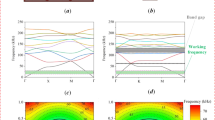Abstract
Shape optimization of two-dimensional lenses for acoustic cameras used in underwater acoustic imaging is presented. To understand elastic shear wave effects of a lens on the pressure field of the medium, we couple two physics models, namely a pressure acoustics model and a linear elastic model and formulate it in the finite element analysis framework. As a result, the focal length of a lens is calculated to be longer than that in the absence of shear effects. The accuracy of our model is tested against experimental results, and compared with finite element analysis of a single physics model as well as the hybrid method - a method using geometrical acoustics and wave acoustics. Pressure at the focal point is optimized using geometric parameters for lens surfaces as design variables. Performance differences due to temperature change or obliquely incident waves are controlled using design constraints. The effectiveness of our optimization formulation is verified by solving single- and dual-lens design problems.
Similar content being viewed by others
References
E. O. Belcher, B. Matsuyama and G. M. Trimble, Object identification with acoustic lenses, Proceedings of Oceans 2001 Conference, 5-8 November, Honolulu, Hawaii, USA (2001) 6–11.
S. Tsukioka, T. Aoki, H. Ochi, T. Shimura, T. Sawa, T. Nakamura, T. Anada, I. Kaihou and H. Noda, Development of an acoustic lens for an imaging sonar for autonomous underwater vehicle “Urashima” and experimentation in a water tank, Japanese Journal of Applied Physics, 41 (2002) 3970–3973.
T. Nakamura, M. Hashimoto, K. Mori, T. Kamakura and T. Anada, Sound fields focused by a biconcave acoustic lens for normal and oblique incidence, Proceedings of Oceans 2005-Europe 1, 20-23 June, Brest, France (2005) 62–67.
Y. Takase, T. Anada, T. Tsuchiya, N. Endoh, N. Nakamura and T. Tukioka, Real-time sonar system using acoustic lens and numerical analysis based on 2D/3D parabolic equation method, Proceedings of Oceans 2005-Europe 1, 20-23 June, Brest, France (2005) 23–28.
E. O. Belcher, D. G. Gallagher, J. R. Barone and R. E. Honaker, Acoustic lens camera and underwater display combine to provide efficient and effective hull and berth inspections, Proceedings of Oceans 2003 Conference, 22-26 September, San Diego, California, USA (2003) 1361–1367.
M. Sikora, I. Mateljan and N. Bogunovic, Beam tracing with refraction, Archives of Acoustics, 37 (3) (2012) 301–316.
K. Fink, Computer simulation of pressure fields generated by acoustic lens beamformers, M.Sc. Thesis, University of Washington (1994).
F. Iijima, T. Tsuchiya and N. Endoh, Analysis of characteristics of underwater sound propagation in the ocean by a finite difference time domain method, Japanese Journal of Applied Physics, 39 (2000) 3200–3204.
K. Mori, H. Ogasawara, T. Nakamura, T. Tsuchiya and N. Endoh, Design and convergence performance analysis of aspherical acoustic lens applied to ambient noise imaging in actual ocean experiment, Japanese Journal of Applied Physics, 50 (2011) 07HG09-07HG09-6.
Comsol, Acoustics Module User’s Guide, Version 4.3 (2012).
Comsol, Optimization Module User’s Guide, Version 4.3 (2012).
D. Givoli and B. Neta, High-order non-reflecting boundary scheme for time-dependent waves, Journal of Computational Physics, 186 (2003) 24–46.
J. P. Bérenger, A perfectly matched layer for the absorption of electromagnetic waves, Journal of Computational Physics, 114 (1994) 185–200.
M. Drozdz, Efficient finite element modelling of ultrasound waves in elastic media, Ph.D. Thesis, Imperial College of Science Technology and Medicine London (2008).
L. E. Kinsler, A. R. Frey, A. B. Coppens and J. V. Sanders, Fundamentals of Acoustics, Fourth Edition (2000).
Y. H. Lo and R. Leonhardt, Aspheric lenses for terahertz imaging, Optics Express, 16 (2008) 15991–15998.
J. Wu and H. Bian, Beam-forming and imaging using acoustic lenses: some simulation and experimental results, Proceedings of 2nd International Conference on Signal Processing Systems, 5-7 July, Dalian, China (2010) 764–768.
Author information
Authors and Affiliations
Corresponding author
Additional information
Recommended by Associate Editor Jeong Sam Han
Quang Dat Tran received his M.S. degree from Department of Mechanical Engineering, Sejong University, Korea in 2013. He is currently a Ph.D. candidate at Department of Mechanical Engineering, Sejong University. His research interest is topology optimization for acoustic problems.
Gang-Won Jang received a B.S. degree in mechanical engineering from Seoul National University in 1998, M.S. and Ph.D. from Seoul national University in 2000 and 2004, respectively. He is an Associate Professor at Faculty of Mechanical and Aerospace Engineering, Sejong University. His research fields include structural optimization and thin-walled beam analysis based on higher order beam theory.
Rights and permissions
About this article
Cite this article
Tran, Q.D., Jang, GW., Kwon, HS. et al. Shape optimization of acoustic lenses for underwater imaging. J Mech Sci Technol 30, 4633–4644 (2016). https://doi.org/10.1007/s12206-016-0934-7
Received:
Revised:
Accepted:
Published:
Issue Date:
DOI: https://doi.org/10.1007/s12206-016-0934-7




